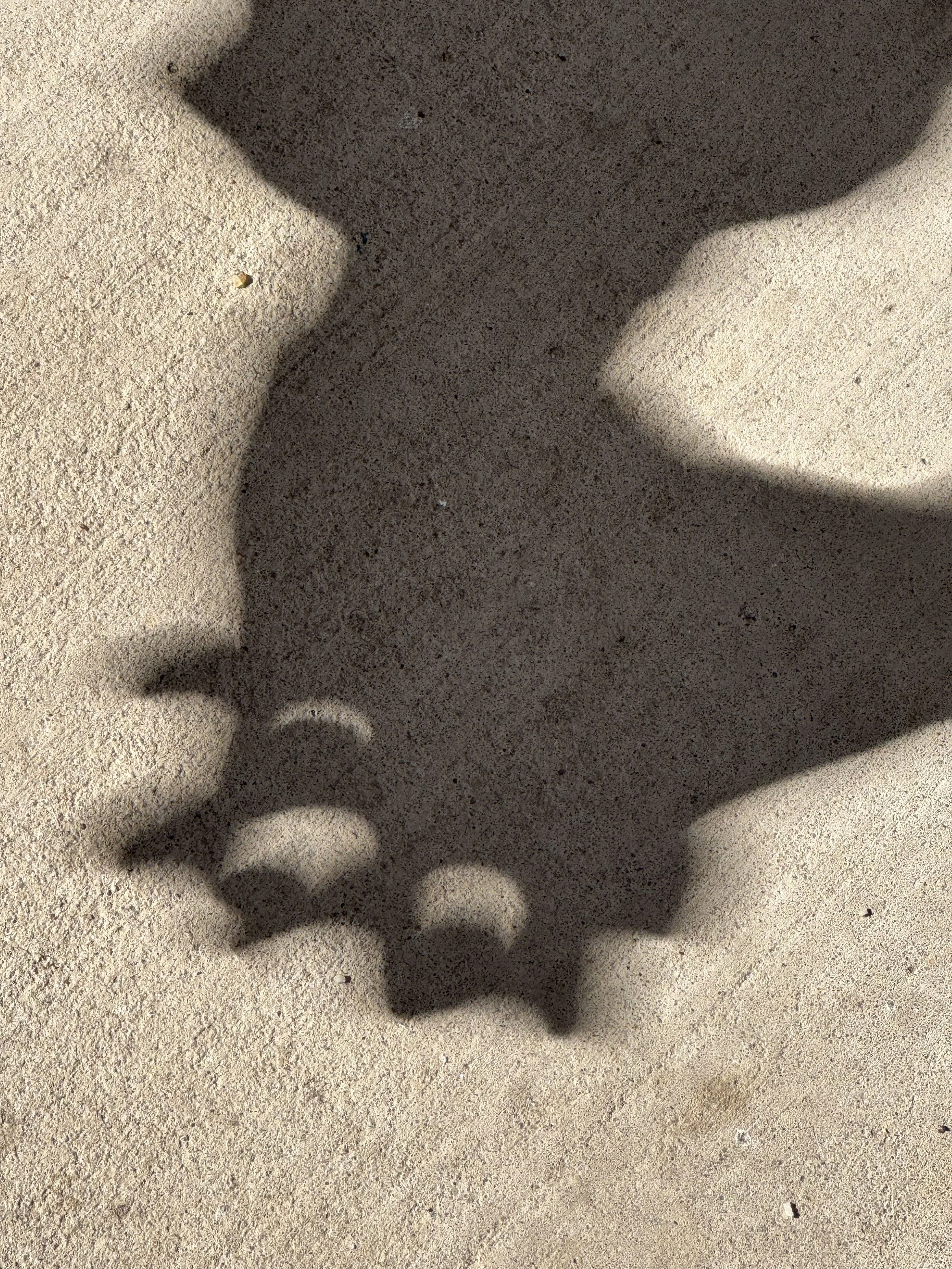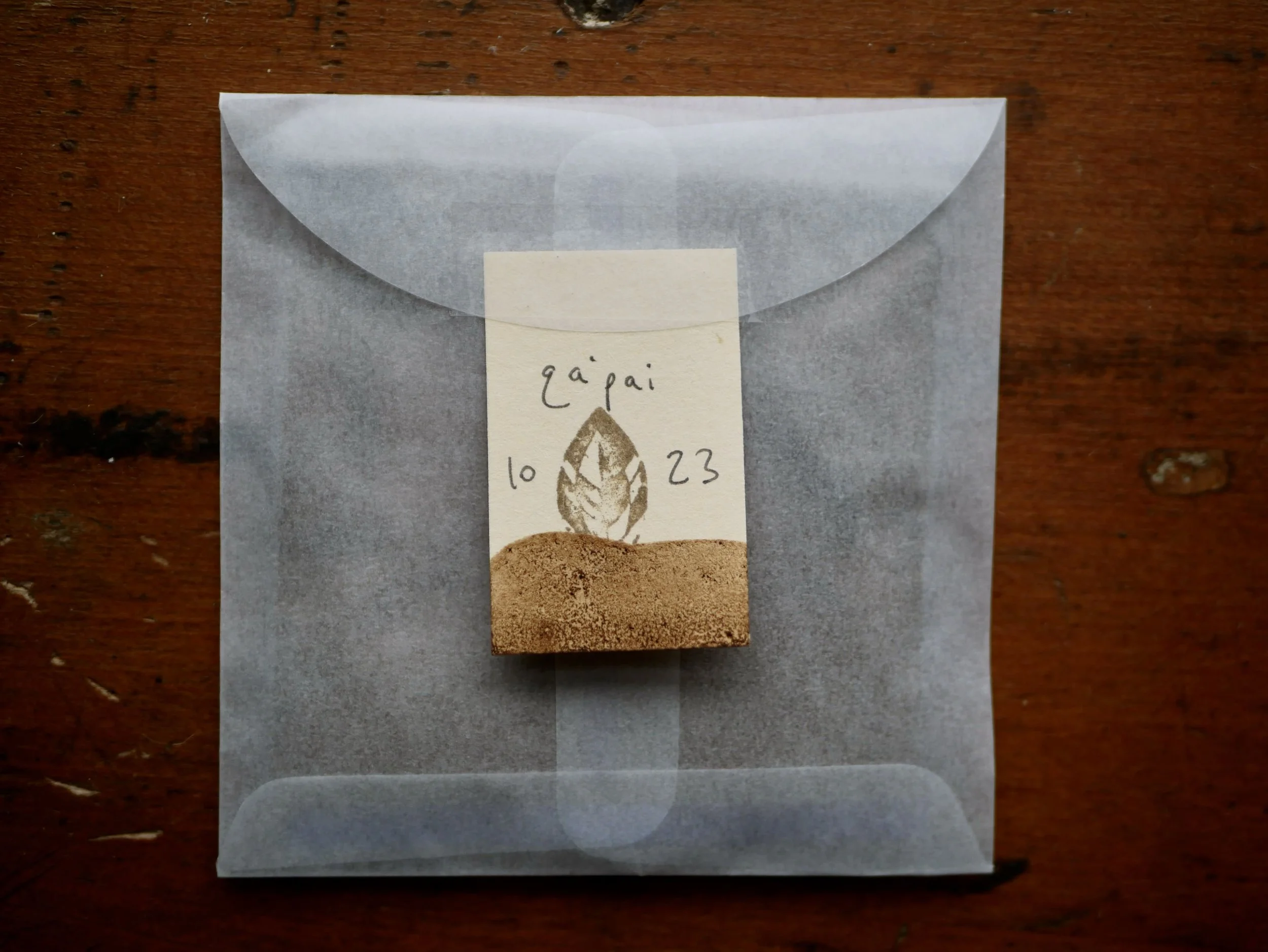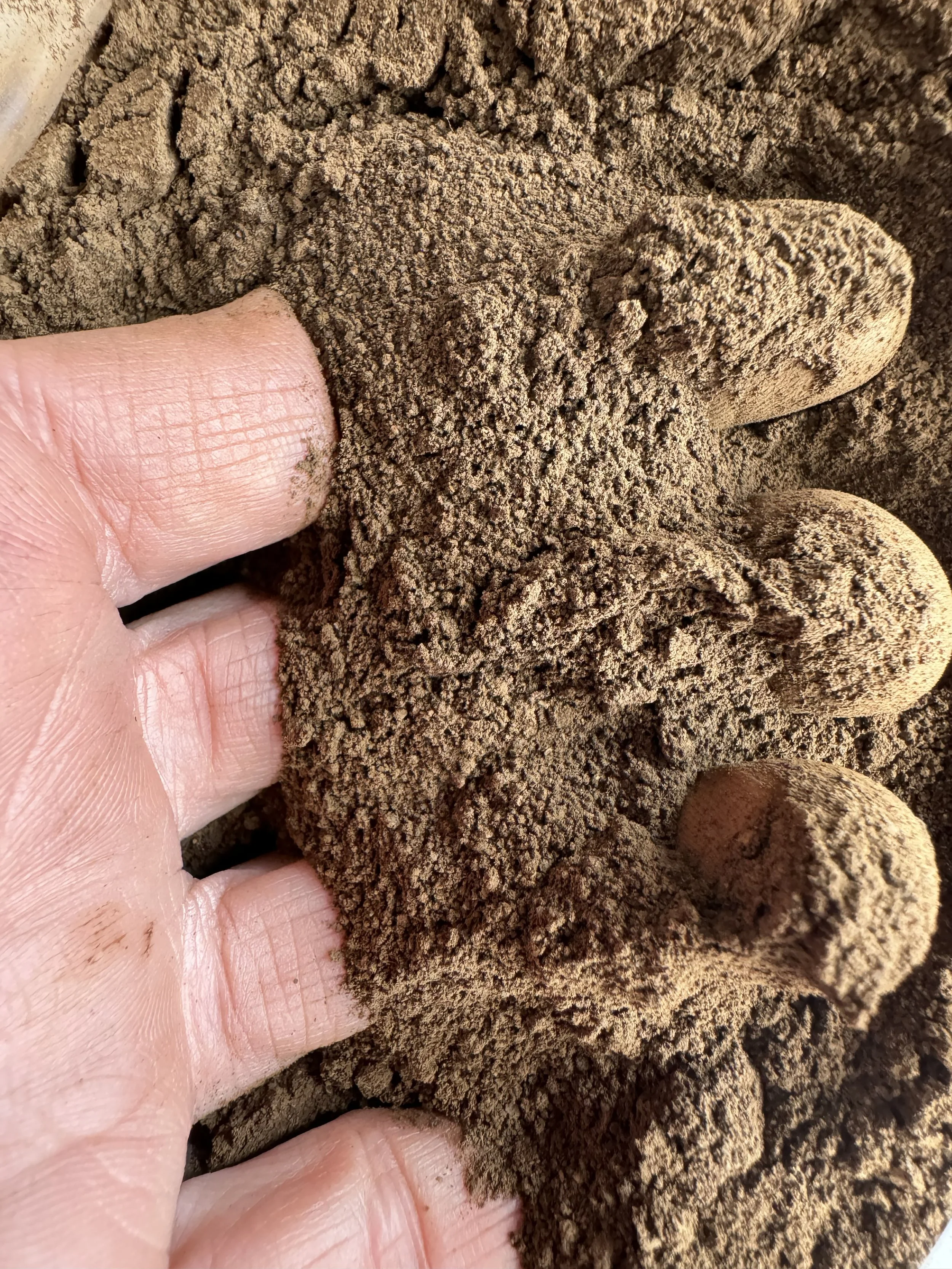pied midden : issue no.45 : qa’pai / good-bye : tilke elkins
The sun’s light and dark, filtered through crossed fingers during this month’s eclipse.
calcinations
You know that feeling of digging around in a bag for something? The hunger you get to feel the shape register on your palm so you can seize what you’re looking for and pull it out into the light? I’ve felt something like that these past few weeks: a digging and pawing around in the dark tangle for a familiar shape, a moral clarity, something.
There are fragments of knowing, solid recognitions of what is clearly wrong. Massacres and kidnapping, the relentless bombing of children, global outbreaks of antisemitism, the brutalization of people engaged in peaceful protest, decades of terror and killings, centuries of prejudice…. Hatred towards the other. Also, unquestioned hatred towards racists, antisemites, and xenophobes: this hatred an inversion of the others, with the same emotional root: the conviction that ‘those people who hate are monsters who deserve to die.’
What fits perfectly into your palm on one side is jagged and cuts into your flesh on the other side. The imperative to destroy a child’s murderers is as powerful as the knowing that dismantling hate for other people is the only road to ending cycles of violence.
Power and money, global capitalism and the funding of wars and other violences that will keep the dollars rolling into the familiar coffers while holding up hatred and vengeance as excuses to devastate the planet — these forces, which run through people but cannot to be traced to any one person — this is the monster that deserves to die. How can we kill it in ourselves? How can we maintain a moral compass when our own actions feed the beast we oppose?
How can we learn to see this beast that runs through nearly everything?
And…how can we craft a new narrative that will release us from being caught in a cycle where we are forced to weigh or justify killings?
When will you speak out? When will you hold your tongue? Do you have the courage to listen for your own response, for your own inner clarity, to wait until you feel capable of discernment? Is that patience appropriate in times like these?
What do we do when the clamor of the machines of war drown out all our calls for a ceasefire?
Wild pigment dusts bring me to questions, challenge me to calibrate my inner compass by exposing its unexamined weaknesses to others who might break open my ignorance and my learned prejudices, might teach me something that will help me grow. I’ve spent nearly five years now asking questions in an attempt to hone my muscles of discernment, to learn more about what it means to forage for art materials. What it means to me, a descendant of English settler-colonizers. What it means to people with indigenous ancestors, and to people who were brought here as enslaved people, and to people who consider themselves immigrants and therefore feel that they are none of these. I don’t have clear answers. I have a depth of awareness and perspective-taking that I didn’t have before, one that might be able to help me to act.
If you’re hell-bent on making up your own mind about things like I am — instead of placing your decision-making process in the hands of someone else — then the ability to discern where you really stand on any given thing is probably going to take time, especially when you’re on unfamiliar ground. It’s possible to feel left behind, in these instances, unable to act when everyone around you is taking shelter in the certainty of shared moral conviction.
I’m here to say, if that path calls to you, keep at it. Use beautiful and terrible questions as guides to lead you towards discernment. Ask those questions of books, ask them of friends, make friends in order to ask them. Put yourself through the fire so you can break, crumble and dissolve. Whatever’s left is what will help you make decisions you can trust. Ones that catalyze you to act — for change, for healing, and for reciprocity.
good-bye ground bright?
The name entered my fingertips the instant I touched the bruised yellow-green husk at the base of the half-naked black walnut tree: Good-bye. That’s when I knew it was the last one.
Good-bye. I said it to myself in a soft voice. Time to go. The moving truck was idling on a side street. It was nearly dusk, and I could feel the day narrowing its jaws around me. Good-bye. Time to let go. Of this place. Of some deep heart attachments I formed here. Of ways of being that no longer serve me. Time to go.
Time to — mindfully, gratefully, prayerfully — shove as many nuts in this bag as possible and blast that truck out between the sinking sun’s lowering fangs, into the canyon and out of the valley and into the mountains and across the desert and into another home calling me to it.
When my fingers closed around that first fallen nut in its husk, back in September, I didn’t know the Kalapuya word for ‘goodbye’ yet. I also didn’t know that the same word — Qa’ Pai — means both good-bye and hello. When I found that out from Dr. David Lewis, Kalapyua, historian and author of Quartux, a brilliant online history journal that’s taught me much of what I know about Oregon history, I had to smile. Too true. This good-bye is also a hello. And I remembered the last time I saw the face of a new friend last April — one of those people you’ve always and forever known, and meeting is really just a footnote — backing away from me into the dusk and saying it as she vanished: ‘Hello.’
goodbye, ground bright
I meant what I said: in a sense this month’s pigment, a beautiful rich black walnut powder, is officially the last Ground Bright pigment. Good-bye!
Wait, am I serious?
First, let’s breathe that in for a moment.
Goodbye, Ground Bright!
After four and a half years together (some of you with us the whole way), it’s time to say good-bye to monthly pigments in mail boxes, and monthly Pied Midden newsletters in your in-box. Subscribers: you’ve affirmed this project over and over. You’ve let the GB pigments lead you down exhilarating, revelatory and sometimes scary paths into new relationships with yourself, the land you walk on, and your communities. You’ve been moved to delight and, perhaps, nudged towards hard questions.
Pigment contributors: I made an outrageous call when I started all this. I invited you to give me — as pure gifts — the beloved pigments you gathered from the land, grew in your gardens, alchemized in your shops, and gleaned from discards. To give me the many hours you spent grinding, sifting, smoothing, growing, heating, melting, crushing, boiling, laking and lovingly wrapping up and shipping these pigments to me. I had no idea how this would go, or whether it would last more than a few months. But month after month, for…52! months your generosity has flowed, the pigments have rolled in, and out, and I’ve surfed an unbroken wave of writing, interviewing, connecting, plotting, and collaborating. Reciprocity in action.
This October marks four years that Noel Guetti has spent each month carefully scooping pigment into baggies, painting tags, printing and hand-cutting cards, stuffing envelopes, and keeping general track of you subscribers. To call it a labor of love is an understatement. Together, we’ve never missed a pigment, and we’ve never been more than a couple of days late getting the pigments out to you. Until this month, that is. We had…things to think about. As you can imagine.
Together we’ve raised, to date, $36,765.44 to give to the land and the people who steward the land, as reciprocal offerings for these dusts that bring us so much joy. If you’d told me when I started this that I’d be giving the equivalent of nearly three years of my annual income at the time away in the course of the project, to people whose work I deeply admire, I would not have believed you. Back then, making a financial donation of any kind was a fantastical concept. Write to me, btw, if you want to see the donation receipts.
Thank you, Noel, for co-crafting this project with me through our many many hours of impassioned discussion, sleepless nights, and, especially in the early days, my fits of panic and frustration. Thank you for lighting the fire and weathering the storms and now, gracefully moving on towards your hallowed future as a loom whisperer and brilliant imparter of loom wisdoms. Gratitude beyond words.
We couldn’t have pulled this off without all the resonance and enthusiasm that’s fueled the Ground Bright thang. The very sharp German paper cutter, on long-term loan from Rebecca Childers at the U of O printshop, the global stamp and the oversize domestic stamp, postal workers in 17 countries, and my pigment mentors all around the globe: wow! It has been relentless good vibes.
Thank you iron-ball earth: parent, teacher, healer, destroyer, home. Thank you Kalapuya rivers and trees and green green rocks for holding me. Thank you mountains and deserts, homelands of diverse peoples, for catching me now.
Good-bye, Ground Bright!
hello, ground bright
It’s over…
But it’s not over.
Letting go of Ground Bright in its current, monthly form coincides with a new vision for Wild Pigment Project, one where the project’s mission is explicitly oriented to highlight artists working with foraged pigments for regenerative economics, the end of racism and antisemitism, and the healing of land histories linked to enslavement, genocide and extraction. In short, artists whose work is a dedication to action, healing and reciprocity with land.
But guess what? Ground Bright will in fact go on, just not as a monthly pigment subscription. It will be more like a way to offer monthly support for Wild Pigment Project, and receive regular surprise pigments in the mail as thank you gifts. Your monthly payments will support the artists giving the Pigments As Catalysts talk series, so all subscribers will have free admission to those talks, plus a bunch of other perks. If you like the sound of all that, do nothing — just stay subscribed (at the same $22/month) and you’re automatically a new Ground Brighter. If you want to cancel, do it by November 12 at 8 am PST.
There’s one more monthly pigment coming your way: a gift from the GB archive, chosen from the pigments I still have in a set of jars in my pigment library. Classics like mauve Providence, violet Atyban Mague, jet black Wandering Winterkill, yellow-ochre Paper Tiger and olive green Hillside Slough…which one will come to you, current subscribers, I wonder? Hardcores out there, feel free to write and let me know your preference, though I don’t have everything, so no promises.
I’m so curious to see who will stick with me on this upcoming journey, and who will join anew. Freedom from monthly pigments will mean that it’s possible to offer an array of small-to-tiny-batch pigments from all kinds of different artists and pigment situations. Mushroom lakes, waste-water vivianite, orphaned pigment collections, wildflower petal ink clothlets, driveway chlorite, rescued pink earths….so many possibilities.
The new new newsletter’s called Pigments As Catalysts. You don’t need to subscribe — I’ll just send it to you instead of this one.
And dearest readers, is there a pigment calling on you to collaborate in a contribution? Here’s what the new invitation looks like:
Wild Pigment Project welcomes foraged & gleaned pigment contributions from pigment practitioners who work in reciprocity with land and communities, publicly centering values of land stewardship, anti-racism, and interspecies equity through action and creative expression. Does this sound like you?
If yes, we’re interested in:
1. pigments gathered from land that your ancestors have been in relationship with for five or more generations, and which your community supports you to contribute to this project,
and/or
2. pigments produced from abundant botanical or mineral materials gleaned from waste streams like construction sites, dissolved firearms, junk yards, kitchen composts, garden trimmings, acid mine drainage pollution rehabilitation, abandoned collections, or other materials discarded by humans that can be made into dry artist pigment.
Read more, and fill out a form, here.
pigment catalyzers
Another big part of this latest evolution for Wild Pigment Project is a focus on talks in the Pigments As Catalysts series. Our inaugural talk, Insurgent Pigments: Material Animacy for a Livable Future, was a smash hit. We raised enough $$ to pay both Hannah and me for our time. THANK YOU, attendees. The series will continue to fund artists whose work challenges the corporate entities which run most museums and galleries. Watch the recording here (free for all live attendees).
Our next Pigments as Catalysts artist is Lucille Junkere, whose work many of you are familiar with. Lucille is a visual artist, educator and researcher who focuses on the legacy of colonialism in African Caribbean textile history and the dispossession caused by the transatlantic slave trade. She’ll be discussing scientific racism in botanical collections, as well as her ongoing research into indigo, logwood, ochres, Welsh wool and slavery. We’ll be announcing the talk date early in the new year.
The Pigment People Directory, which listed about 60 people working with wild pigments worldwide, will eventually be replaced by a new section featuring artists working with pigments as catalysts for work around regenerative economies, equity and the healing of damage to land and communities. There are so many artists working with pigments internationally these days, that it makes sense for this project to shift its focus from pigment practitioners in general to those working with pigments to cultivate these dialogues. Much thanks to all who have been a part of the PP directory!
You can view some of the changes to the Wild Pigment Project website here. A new ‘links & books’ section is in the works. If you have any sites or book to recommend — ones that center the transformative power of connection/action/art/pigments/dyes — do drop me a line. I’ll also be looking for artists whose work falls into that same arena in coming months.
Curious to dig into the exploration of pigments as catalysts in a community of learning? That will be the focus of my up-coming six month online course, Being With Pigments, which begins on December 19th/20th. There are still a few openings. Go here for details.
Will you come with me into this newly phoenixed version of this ever-changing project? I know some of you won’t, and I’m cool with that. But I’m really delighted to see who holds on.
Thoughts on the change or ideas for me or the newness? Write to me at info@wildpigmentproject.org or hit reply to this email.
Stay With Us,
<3 Tilke







